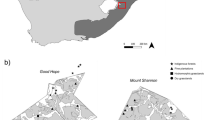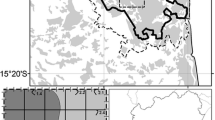Abstract
The New Forest National Park is a hotspot for biodiversity in the UK. A long history of grazing by ponies in the New Forest landscape has created a diverse mosaic of habitats that are of international significance. We investigated patterns of species diversity and composition across the New Forest landscape by sampling soil, leaf litter and ground macrofauna from woodland, grassland and heathland plots across the entire landscape. We used a spatially replicated design of hand sorted soil pits, Winkler extraction of leaf litter, and pitfall traps. We concentrated on diversity patterns of the following target groups: Coleoptera, Formicidae, Isopoda, Chilopoda, Diplopoda, Opiliones and Lumbricidae. The most striking difference in species assemblages is between wooded and open areas. Woodlands are the most diverse habitats and have a distinct assemblage, largely due to those leaf litter invertebrate species which are only present under a closed canopy. Open areas are less diverse, with diversity particularly low in the wet grasslands. However, the open areas do have a distinct fauna, especially in the wet and dry heaths which are home to a number of rare species, particularly of Formicidae. We discuss the potential conservation problems facing the New Forest and how these might affect soil macrofauna biodiversity in the future and conclude that climate change; over-grazing; and land use changes represent the largest threats. Although a relatively stable landscape which benefits from protection under UK law, changes in grazing intensity or management practices in the New Forest, particularly for some of the habitats of European importance (e.g. wet heathlands), could negatively affect soil macrofauna biodiversity. Climate change may also exacerbate biodiversity decline as a result of increased grazing intensity or changes in management.










Similar content being viewed by others
References
Barker CG, Power SA, Bell JNB, Orme CDL (2004) Effects of habitat management on heathland response to atmospheric nitrogen deposition. Biol Conserv 120:41–52
Borcard D, Legendre P, Drapeau P (1992) Partialling out the spatial component of ecological variation. Ecology 73:1045–1055
Bullock JM, Pakeman RJ (1997) Grazing of lowland heath in England: management methods and their effects on heathland vegetation. Biol Conserv 79:1–13
Chambers BQ, Samways MJ (1998) Grasshopper response to a 40-year experimental burning and mowing regime, with recommendations for invertebrate conservation management. Biodivers Conserv 7:985–1012
Chape S, Harrison J, Spalding M, Lysenko I (2005) Measuring the extent and effectiveness of protected areas as an indicator for meeting global biodiversity targets. Philos Trans R Soc B Biol Sci 360:443–455
Colwell RK, Coddington JA (1994) Estimating terrestrial biodiversity through extrapolation. Philos Trans R Soc B Biol Sci 345:101–118
Colwell RK, Rahbeck C, Gotelli NJ (2004) The mid-domain effect and species richness patterns: what have we learned so far? Am Nat 163:E1–E23
Curry JP (1987) The invertebrate fauna of grassland and its influence on productivity. III. Effects on soil fertility and plant growth. Grass Forage Sci 42:325–341
De Caceres M, Legendre P (2009) Associations between species and groups of sites: indices and statistical inference. Ecology 90:3566–3574
Dimbleby GW, Gill JM (1955) The occurrence of podzols under woodlands in the New Forest. Forestry 28:95–106
Eggleton P, Inward K, Smith J, Jones DT, Sherlock E (2009) A six year study of earthworm (Lumbricidae) populations in pasture woodland in southern England shows their responses to soil temperature and soil moisture. Soil Biol Biochem 41:1857–1865
European Commission (2012) Natura 2000 network http://ec.europa.eu/environment/nature/natura2000/index_en.htm. Accessed 12 March 2012
Flower P (1980) The management history and structure of unenclosed woods in the New Forest, Hampshire. J Biogeog 7:311–328
JNCC (Joint Nature Conservation Council) (2011) http://jncc.defra.gov.uk/page-4. Accessed 08 December 2011
Krell F-T, Chung AYC, DeBoise E, Eggleton P, Giusti A, Inward K, Krell-Westerwalbesloh S (2005) Quantitative extraction of macro-invertebrates from temperate and tropical leaf litter and soil: efficiency and time-dependent taxonomic biases of the Winkler extraction. Pedobiologia 49:175–186
Leps J, Smilauer P (2003) Multivariate analysis of ecological data using CANOCO. Cambridge University Press, Cambridge
Maudsley MJ (2000) A review of the ecology and conservation of hedgerow invertebrates in Britain. J Environ Manag 60:65–76
McIntyre S, Hobbs R (1999) A framework for conceptualizing human effects on landscapes and its relevance to management and research models. Conserv Biol 13:1282–1292
Newton AC (ed) (2010a) Biodiversity in the New Forest. Pisces Publications, Newbury
Newton AC (2010b) Fungi. In: Newton AC (ed) Biodiversity in the New Forest. Pisces Publications, Newbury
Oksanen J, Guillaume BF, Kindt R, Legendre P, O’Hara RB, Simpson GL, Solymos P, Stevens MHH, Wagner H (2011). Vegan: community ecology package. R package version 1.17–12. http://CRAN.R-project.org/package=vegan
Pielou E (1966) The measurement of diversity in different types of biological collections. J Theoretical Biol 13:131–144
Sanderson NA (2010) Lichens. In: Newton AC (ed) Biodiversity in the New Forest. Pisces Publications, Newbury
Sedlakova I, Chytry M (1999) Regeneration patterns in Central European dry heathland: effects of burning, sod-cutting and cutting. Plant Ecol 143:77–87
Smith J, Potts S, Eggleton P (2008) The value of sown grass margins for enhancing soil macrofaunal biodiversity in arable systems. Agric Ecosyst Environ 127:119–125
Stern R (2010) Bryophytes. In: Newton AC (ed) Biodiversity in the New Forest. Pisces Publications, Newbury
Stewart AJA, New TR (2007) Insect conservation in temperate biomes: issues, progress and prospects. In: Stewart AJA, New TR, Lewis OT (eds) Insect conservation biology: The 22nd symposium of the royal entomological society. CABI, Wallingford
R Development Core Team (2011) R: a language and environment for statistical computing. R Foundation for Statistical Computing, Vienna, Austria. ISBN 3-900051-07-0, URL:http://www.R-project.org/
Trudghill S (1989) Soil types. A field identification guide. Field Stud 7:337–363
Tubbs CR (1997) The ecology of pastoralism in the New Forest. British Wildl 9:7–16
Tubbs CR (2001) The New Forest: history ecology and conservation, 2nd edn. New Forest Ninth Centenary Trust, Lyndhurst
Webb NR (1989) Studies on the invertebrate fauna of fragmented heathland in Dorset, UK, and the implications for conservation. Biol Conserv 47:153–165
Acknowledgments
This work forms part of the ‘New Forest Quantitative Inventory’ and was funded by a grant from the NHM’s Annual Fund and the NHM Entomology Department’s Departmental Investment Fund. Thanks to David T. Jones, Barbara Smith, Jo Smith and two anonymous reviewers for comments on the manuscript. Thanks also to the following volunteers for helping with field work and for sample sorting: Keiron Brown, Kate Harrington, Cassius Morrison, Simon Powell, Samantha Ho, Judi Allette, Laura McCoy, Matthew Dickinson, Benjamin Lawrence, Nicky Nicoll, Anna Platoni, Heather Mikhail, Salma Mustafa, Ian Sosney and Gerardo Mazzetta.
Author information
Authors and Affiliations
Corresponding author
Electronic supplementary material
Below is the link to the electronic supplementary material.
Rights and permissions
About this article
Cite this article
Carpenter, D., Hammond, P.M., Sherlock, E. et al. Biodiversity of soil macrofauna in the New Forest: a benchmark study across a national park landscape. Biodivers Conserv 21, 3385–3410 (2012). https://doi.org/10.1007/s10531-012-0369-0
Received:
Accepted:
Published:
Issue Date:
DOI: https://doi.org/10.1007/s10531-012-0369-0




